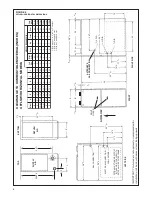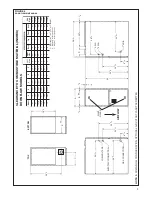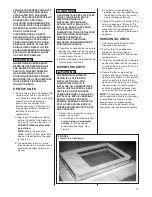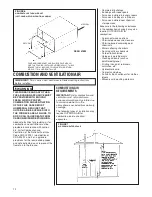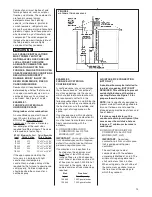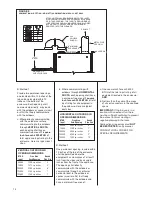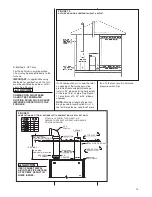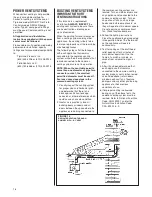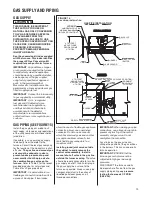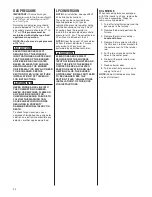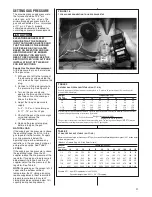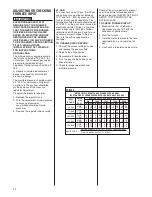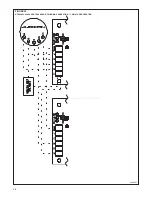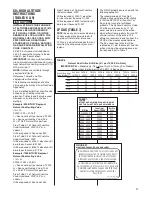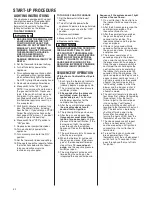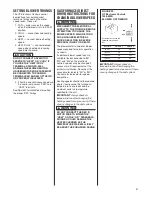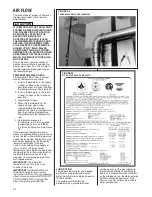
17
“B-1” VERTICAL VENTING
Type “B-1” vents must be installed in
accordance with the terms of their
listings and the vent manufacturer’s
instructions.
“B-1” vents must be supported and
spaced in accordance with their listings
and the manufacturer’s instructions. All
vents must be supported to maintain
their minimum clearances from
combustible material.
VERTICAL VENTING
Categorized
Furnace Vent
Input
Size Required
50K
3
”
75K
*4
”
100K
*4
”
125K
*5
”
150K
*5
”
*NOTE: All furnaces have a 3” vent
connection as shipped from the factory. A 3”
to 4” or 3” to 5” vent transition is required on
all but the 50,000 BTUH models when
vertically vented or common vented with
metal vent pipes.
THE VENT TRANSITION
CONNECTION MUST BE MADE AT THE
FURNACE VENT EXIT.
It must originate
with an adapter if required, at the furnace
flue collar and terminate either in a listed
cap or roof assembly. When common
venting, the vent connector size may differ
from the above diameters depending on
application. See ANSI Z21.47-1993/CSA-
2.3-M93 or latest edition tables.
VERTICAL VENT SYSTEMS:
1. A gas vent shall terminate above the
roof surface with a listed cap or
listed roof assembly. Gas vents 12
inches in size or smaller with listed
caps shall be permitted to be
terminated in accordance with
Figure 14, provided they are at least
8 feet from a vertical wall or similar
obstruction. All other gas vents shall
terminate not less than 2 feet above
the highest point where they pass
through the roof and at least 2 feet
higher than any portion of a building
within 10 feet.
2. A type B-1 gas vent shall terminate
at least 5 feet in vertical height
above the highest connected
equipment draft hood or flue collar.
3. Must rise
1
/
4
” per foot away from the
furnace on horizontal runs and be
supported with straps or hangers so
it has no sags or dips. Supports at 4
foot intervals and at all elbows are
recommended.
4. The vent connector must be
mechanically fastened to the outlet
collar of the furnace with at least (2)
sheet metal screws except vent
connectors that are B-1 material.
DO NOT CONNECT THIS FURNACE
TO A CHIMNEY USED TO VENT A
SOLID FUEL APPLIANCE (WOOD
OR COAL). VENTING WITH A SOLID
FUEL APPLIANCE CAN LEAD TO
IMPROPER FUNCTIONING OF THE
UNIT, AND DUE TO SOOTING, THE
POSSIBILITY OF FIRE RESULTING
IN PROPERTY DAMAGE,
PERSONAL INJURY OR DEATH.
SPECIAL VENT SYSTEMS (SVS)
IMPORTANT:
It is THE FURNACE
MANUFACTURER’s position now that
new installations of any HTPV pipe
used in a category
III
vent application,
including Selkirk’s Selvent™
II
HTPV
product, should cease immediately.
These shall be assembled in
accordance with the manufacturer’s
instructions. See Figure 12.
5. Any angle greater than 45 degrees
from the vertical is considered
horizontal. The total horizontal
distance of a vent plus the horizontal
vent connector serving draft-hood
equipped appliances shall not be
greater than 75 percent of the
vertical height of the vent.
NOTE: Refer to the National Fuel Gas
Code, ANSI Z223.1 and/or the Natural
Gas Installation Code,
CSA-B149.1 & .2.
Single appliance venting of a fan
assisted furnace into a tile-lined
masonry chimney is prohibited. The
chimney must be lined with either Type
B vent or with a listed, single wall,
metal lining system. Reference
National Fuel Gas Code, ANSI Z223.1
and/or the Natural Gas Installation
Code, CSA-B149.1 & .2. See Figure 13
for typical B-1 vent chase.
FIGURE 13
TYPICAL VENTING WITH “B-1” VENT
WARNING
!






